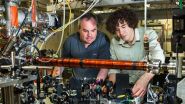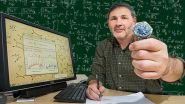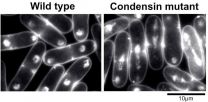Expanding the code of life with new 'letters'
2015-05-27
(Press-News.org) The DNA encoding all life on Earth is made of four building blocks called nucleotides, commonly known as "letters," that line up in pairs and twist into a double helix. Now, two groups of scientists are reporting for the first time that two new nucleotides can do the same thing -- raising the possibility that entirely new proteins could be created for medical uses. Their two studies appear in ACS' Journal of the American Chemical Society.
Synthetic biologists have been attempting for years to expand on nature's genetic "alphabet," consisting of the nucleotide bases cytosine, guanine, adenine and thymine -- also represented by the letters "C," "G," "A" and "T," respectively. But so far, the potential additions they've tested have shown limited promise. For example, one duo pairs up but doesn't form a nice helix, an important criterion given that the bases would have to incorporate fairly seamlessly with the original four to be useful. Millie M. Georgiadis, Steven A. Benner and colleagues from Indiana and Florida wanted to see if another potential set of letters, "Z" (6-amino-5-nitro-2(1H)-pyridone) and "P" (2-amino-imidazo[1,2-a]-1,3,5-triazin-4(8H)one), would form a helix -- and evolve.
The researchers found that multiple Z-P pairs can contribute to a double helix, just as C-G and A-T pairs do, with the same combination of flexibility and rigidity required for natural DNA to function. They also showed that the Z-P pairs integrate well with conventional pairs and that six-letter GACTZP DNA can evolve. The evolution of DNA containing the new building blocks endows the structures with new properties that could be useful in protein recognition.
INFORMATION:
The authors acknowledge funding from the National Institutes of Health, the Defense Threat Reduction Agency, the National Aeronautics and Space Administration and the Templeton World Charity Foundation.
The American Chemical Society is a nonprofit organization chartered by the U.S. Congress. With more than 158,000 members, ACS is the world's largest scientific society and a global leader in providing access to chemistry-related research through its multiple databases, peer-reviewed journals and scientific conferences. Its main offices are in Washington, D.C., and Columbus, Ohio.
To automatically receive news releases from the American Chemical Society, contact newsroom@acs.org.
Follow us: Twitter Facebook
ELSE PRESS RELEASES FROM THIS DATE:
2015-05-27
With summer nearly here, U.S. consumers might think they have an abundance of sunscreen products to choose from. But across the Atlantic, Europeans will be slathering on formulations that manufacturers say provide better protection against the sun's damaging rays -- and skin cancer -- than what's available stateside, according to an article in Chemical & Engineering News (C&EN), the weekly newsmagazine of the American Chemical Society.
Marc S. Reisch, a senior correspondent at C&EN, reports that sunscreens on the U.S. market do protect users from some ultraviolet-A and ...
2015-05-27
Patients treated for an acute respiratory infection by a doctor on a telephone or live video are as likely to be prescribed an antibiotic as patients who are treated by a physician face-to-face for the same illness, according to a new RAND Corporation study.
However, the patients treated virtually were more likely to be prescribed a broad-spectrum antibiotic -- concerning since overuse of the drugs increases costs and contributes to antibiotic resistance, according to the study.
Researchers say both treatment settings had high rates of inappropriate prescribing for ...
2015-05-27
Some children with autism should undergo ongoing screenings for apraxia, a rare neurological speech disorder, because the two conditions often go hand-in-hand, according to Penn State College of Medicine researchers.
Over the course of a three-year study, 64 percent of children initially diagnosed with autism were found to also have apraxia. The study also showed that the commonly used Checklist for Autism Spectrum Disorder (CASD) accurately diagnoses autism in children with apraxia.
"Children with apraxia have difficulty coordinating the use of their tongue, lips, ...
2015-05-27
The bizarre nature of reality as laid out by quantum theory has survived another test, with scientists performing a famous experiment and proving that reality does not exist until it is measured.
Physicists at The Australian National University (ANU) have conducted John Wheeler's delayed-choice thought experiment, which involves a moving object that is given the choice to act like a particle or a wave. Wheeler's experiment then asks - at which point does the object decide?
Common sense says the object is either wave-like or particle-like, independent of how we measure ...
2015-05-27
An international team of scientists studying ultrafast physics have solved a mystery of quantum mechanics, and found that quantum tunneling is an instantaneous process.
The new theory could lead to faster and smaller electronic components, for which quantum tunneling is a significant factor. It will also lead to a better understanding of diverse areas such as electron microscopy, nuclear fusion and DNA mutations.
"Timescales this short have never been explored before. It's an entirely new world," said one of the international team, Professor Anatoli Kheifets, from The ...
2015-05-27
This news release is available in Japanese.
Right before a cell starts to divide to give birth to a daughter cell, its biochemical machinery unwinds the chromosomes and copies the millions of protein sequences comprising the cell's DNA, which is packaged along the length of the each chromosomal strand. These copied sequences also need to be put back together before the two cells are pulled apart. Mistakes can lead to genetic defects or cancerous mutations in future cell generations.
Just like raising a building requires scaffolding be erected first, cells ...
2015-05-27
The method used to calculate Standard & Poor's Case-Shiller Home Price Indices, the most trusted benchmark for U.S. residential real estate prices, contains a flaw that likely could lead to misstating its monthly estimates, according to a newly published study led by faculty at Florida Atlantic University.
The paper published in the Journal of Real Estate Research identifies an important deficiency in the Weighted Repeated Sales (WRS) method developed by economists Karl Case and Robert Shiller, which compares repeat sales of the same homes in an effort to study home ...
2015-05-27
Anti-osteoporotic medication is not an effective means for preventing hip fractures among the elderly, concludes a study recently published in the BMJ.
Proximal femoral fractures (i.e., hip fractures) occur in the world at a rate of 1.5 million per year, or 7,000 per year in Finland. As most such fractures occur among older people, their number is expected to grow as the population ages. Hip fractures often lead to permanently reduced mobility, quality of life and general health, as well as result in significant social costs.
Since the early 1990s, anti-osteoporotic ...
2015-05-27
The teacher's interaction style can either foster or slow down the development of math skills among children with challenging temperaments. This was shown in the results of the study "Parents, teachers and children's learning" carried out at the University of Jyväskylä, Finland.
Ph.D. Jaana Viljaranta, along with her colleagues, studied the role of teachers' interaction styles in academic skill development among children with different temperamental characteristics.
A child's challenging temperament may show up in the classroom, for example, as low task-orientation ...
2015-05-27
When Niels Bohr hypothesised his model of atom with the electrons orbiting the nucleus just like satellites orbit a planet, he was engaging in analogical reasoning. Bohr transferred to atoms the concept of "a body orbiting another", that is, he transferred a relation between objects to other, new objects. Analogical reasoning is an extraordinary ability that is unique to the human mind, is not seen in animals (except very rarely in primates) and that forms the basis of highly sophisticated human thoughts. Scientists have wondered about the origin of this cognitive function: ...
LAST 30 PRESS RELEASES:
[Press-News.org] Expanding the code of life with new 'letters'


